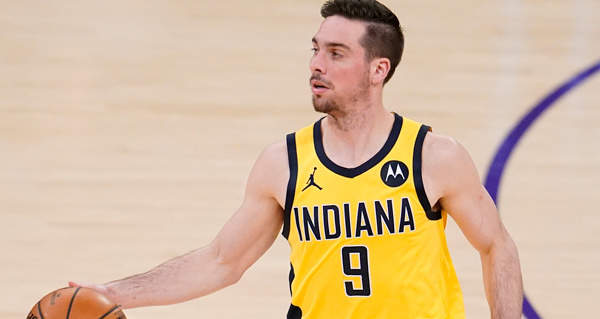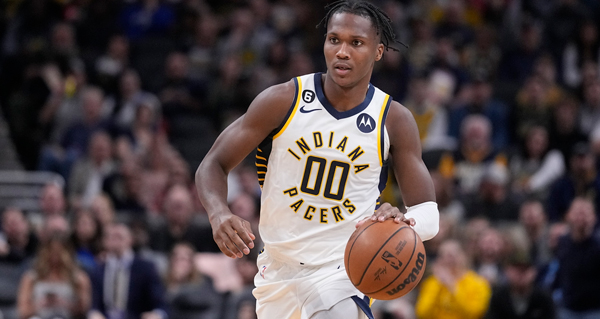The story about the Indiana Pacers’ run to these NBA Finals is changing. Much of the narrative around them has been about improbability, miracle, and shock. But people are starting to understand that they shouldn’t be so surprised, and that this has been a title contender in plain sight for all of the calendar year 2025. In Game 3, rather than an insurgent band of hubristic ballers, they looked like a team that was comfortable and capable in every way we’d expect from a finalist. Their 116-107 home victory was the kind of contest they’ve been winning with great regularity since January; it’s not all explosive comebacks and hothouse conquests. The Pacers can win normal games, too—even against the 68-win Oklahoma City Thunder.
Their depth, this time, was key. Main character Tyrese Haliburton had his best game of the series, but it was T.J. McConnell and Benedict Mathurin who ignited Indiana. Freshly 33 years of age, McConnell is the oldest player getting minutes in these Finals, but is arguably the most energetic presence on the floor. A box score +12 in his 15 minutes played, he collected five steals to go with his 10 points and five assists; making him, for this game, one of the Finals’ greatest per-minute point guards we’ve ever seen. He made the Thunder look lazy, hopping into passing gaps and empty spots near the rim, finding his teammates running their way through head coach Rick Carlisle’s relentless offense (engineered, maybe, with his 1980’s playing days in mind).
Three of McConnell’s dishes were to Mathurin. Though the super-confident 22-year-old who spoke to Giannis Antetokounmpo like they were the same size, three rounds ago, plays more Pacer-style ball than he used to, it’s his ability to break free from the script that provides his team with something extra. If Mathurin—who is made out of lightning, and who I propose we call “Maniac Math,” going forward—can sometimes dribble more than a Pacer is supposed to, it isn’t always a bad thing. He is a supremely talented self-maker on offense, as his 27 points in this game demonstrated. And when he more consistently applies his elite athleticism to his team’s scheme, the results are spectacular.
But it was the Indiana defense that won the night, most of all. McConnell’s five takeaways were the most noticeable, but his team collected eight more, and won a turnover battle that OKC opponents almost always lose. They also blocked 11 Thunder shots, with five of those swats coming from starting center Myles Turner. The glue in the Pacers’ unique structure, his ability to both shoot from three and protect the rim has allowed Indiana to play with scoring speed and spread without sacrificing too much on the other end. It simply doesn’t work without him, and he reminded the basketball world of this with a handful of decisive stops in the clutch.
These sorts of traditional positional strengths were able to shine because the Pacers won the bigger-picture battle of styles, and turned Game 3 into their kind of competition. This was especially evident throughout the fourth quarter, when they outscored a Thunder team that looked uncharacteristically exhausted, 32-18. OKC is accustomed to delivering heavy blows earlier, and finishing teams in the third quarter at the latest, then coasting through the usually pivotal last portions of a game. The Pacers like it differently: run all damn night, all the way to the end, and thrive from the other guys’ gradual depletion. That formula proved viable at the highest stage of the sport, Wednesday night.
The Thunder have been here before, sort of. Though their seven-game struggle against the Denver Nuggets, two rounds ago, required a different kind of guts, it was an important instance of the young squad being forced out of their comfort zone, yet still finding their way through. Right now, that means discovering offensive productivity that is less dependent on their MVP, because the Pacers are showing an ability to fluster and jam up the process for Shai Gilgeous-Alexander with crowd defense, mixed coverage, and the general forcing of a more complex and physical decision tree. He had more turnovers than assists in the Thunder loss, and was well beneath his typical scoring volume and efficiency.
Before the Finals began, I wrote that it would be a science experiment of a series, in which we see whether OKC’s unusually active defense or Indy’s hyper-kinetic offense would prove the superior component in the petri-dish. We’ve still got our eyes glued to the microscope, but at the moment, the Thunder need to re-prove that what they do can elementally overwhelm any other team’s approach to the sport. Vegas betting odds still say that they can achieve this, but the numbers are far less juicy than they were a week ago. That's because the Pacers keep showing themselves to be better than any analysis has accounted for, and pulling us further into the realm of uncertainty. Friday night, when the referee throws the ball up at halfcourt, it's from that new and unknown place that the state of the sport will proceed.






